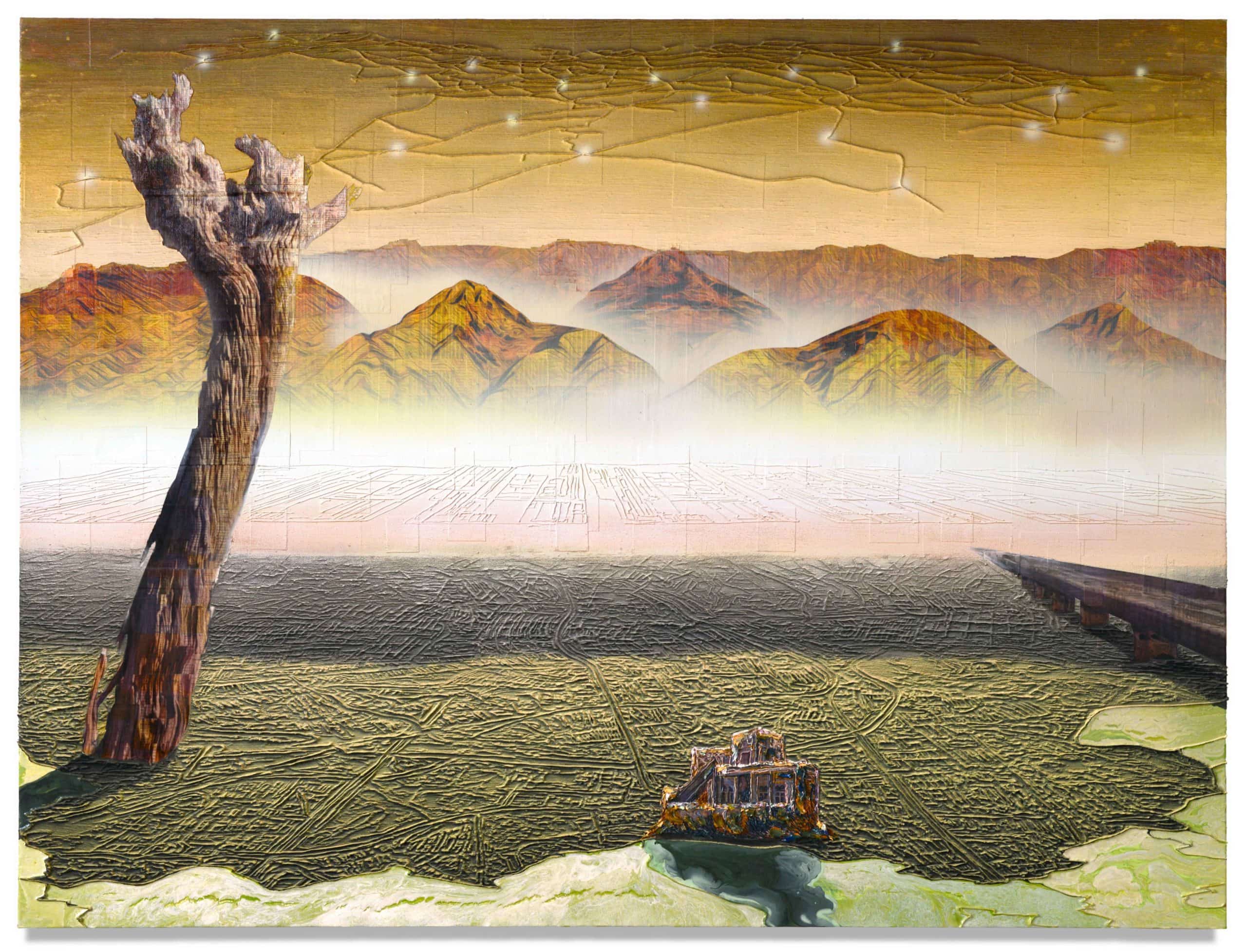

Megalopolis, 2020, Financial newspaper, archival inkjet, sand and acrylic on canvas, 150 x 200 cm, 59 1/8 x 78 3/4 in., (GC.2020.001)
You see, my recent trips to galleries have been inundated by ‘futuristic’ paintings covered in plains of fluorescent colour, usually with some reference to a robo-house that you’d find in an episode of Black Mirror, and occasionally an ‘overlooked’ object that supposedly defines the human experience.
I thought this was what I was about to get myself into, and I’m not mad on art which tries so overtly to make me have some sort of existential crisis.
Rooted within both the history and contemporary world of China, his paintings speak an entirely different language on the future
My presumptions were totally off. Gordon Cheung’s paintings are arguably not futuristic at all, despite elements of them initially appearing so. This is a result of Cheung’s work being rooted within both the history and contemporary world of China, which allows his paintings to speak an entirely different language on the future.
Cheung’s works seek to portray his personal experience in watching the progression of China becoming the 21st century global superpower that it is today. The series of five paintings presented for ‘Tears of Paradise’ – Cheung’s fourth solo show at Edel Assanti – focuses on both real and prescient landscapes from China, while exploring the plans for China’s megacity, Jing-Jin-Ji, which has a projected population of 100 million people.

Tears of Paradise, 2020, Financial newspaper, archival inkjet, sand and acrylic on canvas, 150 x 200 cm, 59 1/8 x 78 3/4 in., (GC.2020.005)
The material quality delivered throughout the works is astounding. Cheung begins each work by creating a backdrop of a digital cityscape, through applying a combination of Financial Times pages and inkjet aerial images of specific locations in China, sourced from Google Maps. Each piece of pasted paper builds up the initial playground for innate layering.
Throughout the works, Cheung uses sand to create texture in the foreground. When viewing ‘Desert of the Real’ I was left peering down the side of the canvas. The application of this tactile medium to form a maze of maps, made it look as though it was digitally rendered when viewing from front on. This opposition of natural relief and digital foundation bringing Cheung’s realisation full circle.
There’s abstracted hills with radiating outlines and deep, incandescent horizons. Or subtle additions of otherworldly plants, animals, buildings, and boats
There’s abstracted hills with radiating outlines and deep, incandescent horizons. Or subtle additions of otherworldly plants, animals, buildings, and boats at the base of the paintings, in stark contrast to hyper-real trees, playing on the relationships between the imagined and the real.
Cheung utilises repeated patterns of constellation-like maps at the top of the paintings, which appear to be plotting out maps of the future.

Tears of Paradise, Gordon Cheung, 2020, Edel Assanti
The attention to colour is a nod to the surreal, but in a way that’s just as gloomy as it is wondrous. This is thanks to careful, dripping gradients, thoughtful application of moody grey tones and a recurring use of seemingly glowing acrylic.
The installation of sculptures, ‘Home’, steals the show and resembles, from afar, exactly what Cheung intended: traditional window designs from homes in China. These homes being those which are effortlessly demolished for urbanisation.
The attention to colour is a nod to the surreal, but in a way that’s just as gloomy as it is wondrous
Upon closer inspection, the bamboo frames of these detailed structures have been coated, again, with the Financial Times newspaper, Cheung’s material of choice.
This could’ve very easily been gimmicky, reminiscent of handbags made from old magazines bought at markets on holiday, but the application of the material gives it a new visual language, one that you can literally read. It’s formed a casing around the shell of these viewing structures, which when walked through, provide a sense of looking out upon an uncertain time to come.

String of Pearls, 2020, Financial newspaper, archival inkjet, sand and acrylic on canvas, 150 x 200 cm, 59 1/8 x 78 3/4 in., (GC.2020.004)
Downstairs, one of Cheung’s earlier works is available to view, which centres around a traditional Chinese vase. It’s here we see the continual role of material texture that has been a cemented focus of the artist’s practice. Leaves have been applied directly onto the canvas – small universes of dried-out paint, the kind that you’d peel off of a paint palette at school, have been used as swirling petals.
Small universes of dried-out paint, the kind you’d peel off of a paint palette at school, have been used as swirling petals
The works are both frightening and bewitching, and through the combined uncovering of the past and present, forge a nuanced reaction. Not the crisis type, but a singular, disturbing consideration towards what the future hold for this particular, powerful part of the planet. Moral of the story: Don’t Google exhibitions before you go.
Gordon Cheung’s work is exhibited at Edel Assanti until this Saturday (7th March). For more information click here.
Edel Assanit, 74A Newman St, Fitzrovia, London W1T 3DB


